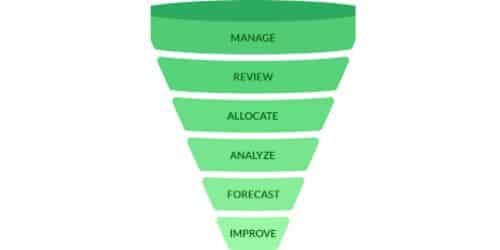The numerous stages a business takes to engage clients up until they complete a purchase are known as the sales pipeline. To handle these sales pipelines effectively, businesses conduct market research, foresee their demands, and create sales presentations. Understanding the various stages of a sales pipeline will assist you as a sales professional build strategies and optimizing the process to achieve your sales goals. In this post, we will be going deep into the sales and software for the management of pipeline salesforce.
Pipeline Management
The various procedures required in sustaining business sales for each step are referred to as pipeline management. All the steps in the sales process are shown visually in this method. These procedures might involve formulating plans of action, finishing evaluations, and making adjustments.
Guidelines for Improving a Sales Pipeline
A sales strategy like pipeline management isn’t one you focus on at the start of the year or the start of a quarter. It’s something you have to do each day.
#1. Pay Attention to the Possibility
In the early stages of the sales pipeline process, certain customers exhibit more prospects than others. It’s crucial to target marketing efforts toward clients who are likely to be interested in the product and service offered.
#2. Regularly Update the Sales Funnel
The sales pipeline should be updated on a timeframe with new customer information and content. The organization benefits from increased participation and a better understanding of emerging trends. In addition, you can update the sales pipeline using evolving client data.
#3. Shorten the Sales Cycle
The act of introducing a customer to products and influencing them to buy is accelerated by shortening the sales cycle. Because it generates more revenues, the quick sales cycle is also more effective.
#4. Continually Pursue Leads
When you find potential customers who are ready to buy, you can follow up with them. This procedure comprises getting in touch with potential customers and helping them finish a transaction. To enhance retention rates, you can also respond to inquiries and keep up with client interactions.
#5. Boost Interaction with Customers
You may increase sales and better manage the pipeline by enhancing client interactions and engagement at every level. As you endeavor to give clients a more effective and smooth journey, this approach aids in time and resource savings. Making decisions about potential clients, developing product offers, and choosing sales channels are all possible steps in the process.
#6. Follow Sales
The sales and marketing team may establish key performance indicators and metrics while managing the sales pipeline to assess the effectiveness and expansion of the sales process.
#7. Predicts Sales
You can locate KPIs that are related to business revenue when you manage a company’s sales pipeline. Additionally, you can spot the sales trends that affect a company’s revenue over a specific time frame. The ability to design and approve budgets as well as financial plans that you can share with corporate stakeholders is made possible by the ability to predict revenue.
Pipeline Management Sales
The process of handling incoming sales opportunities and following them through the various phases of the lead’s journey until they are finally closed as won or lost is sometimes described as sales pipeline management. It might be difficult for a company that relies on spreadsheets to monitor sales and follow-ups as they increase and change.
The Importance of a Sales Pipeline in CRM
You can quickly see where each customer is in the sales process by looking at a sales pipeline. This knowledge aids in your decision-making as to the following actions you should take to seal the deal. If you are on track to meet your sales goals for the week or month, your pipeline can let you know. Based on their lead conversion rates, you can also infer how well your sales representatives are performing. In short, the core of every company’s sales process is pipeline management software. It is a dynamic, living thing that must be continuously observed to ensure its well-being.
Who Should Use a Pipeline Management CRM?
#1. B2B
According to B2B company research by the Harvard Business Review, businesses that had a formal sales process outperformed those that didn’t have one by 18% in terms of revenue growth. Designing sales pipelines and creating plans to improve sales rep performance is made easier with the aid of pipeline management systems.
#2. Small Companies
Small enterprises are improving their business intelligence. Instead of unscalable, error-prone spreadsheet lead paperwork, people are increasingly choosing a better option.
#3. Sales Executives
CRM pipeline management makes it possible to precisely and conveniently measure crucial revenue and productivity indicators. Additionally, managers can monitor bigger agreements that are in the works and take action as needed.
#4. Sales Agents
Salespeople can efficiently move prospects through the pipeline’s various stages by using a well-defined sales process. With timely reminders and notifications, follow-ups are simple.
Pipeline Management Software
CRM (customer relationship management) systems for sales are often known as sales pipeline management software. The salesperson’s CRM platform is where all pipeline tracking and prioritization actions take place. It supports the tracking and management of each individual sales opportunity as well as the distribution of all opportunities by sales representatives and/or sales managers. This pipeline management software includes the following:
#1. MoData
MoData is a sales intelligence tool powered by AI that gives businesses information on all key sales KPIs to aid in making data-driven business choices. Pipeline analysis, sales forecasting, revenue analysis, and account-based sales reports are examples of key capabilities. Users of the self-service solution can manage pipelines, leads, sales funnels, and sales activities thanks to the self-service solution’s hundreds of pre-built widgets and sales KPI charts/reports.
#2. Korero
This is made to be a one-stop shop for CRM, collaboration, and communication with automation tools to empower and increase the effectiveness and productivity of your sales team. Korero, which is primarily targeted at B2B and Small and Medium-Sized Businesses, has a streamlined User Interface for an excellent User Experience.
#3. Bigin by Zoho CRM
A pipeline-focused CRM designed and priced for small and micro businesses is called Bigin. Bigin, a member of the Zoho customer relationship platform family, is made to assist small businesses in eschewing spreadsheets and antiquated sales tools in order to manage their client interactions. The vendor touts its straightforward user interface as simple and easy to use, especially for users without much CRM knowledge, with a feature set that is adaptable enough to meet any business model and is reasonable in price for small businesses.
#4. InsideSales.com / XANT Predictive Pipeline
With Neuralytics, the XANT prediction engine, the prediction funnel maintained track of every change in the sales funnel and forecasted quota attainment with an impressive 80% accuracy. The product, which was built on C9 Predictive Sales and was no longer for sale, was owned and supported by XANT (previously InsideSales.com) from May 2015.
#5. Vtiger
Through integrated marketing, sales, and customer support software, Vtiger produces free open-source and subscription-based cloud CRM software to assist organizations in better engaging with their customers throughout the whole customer life cycle. The seller claims that their product increases revenue, customer satisfaction, and marketing ROI. Collaboration, project management, inventory management, process automation, and a number of other features are also included in Vtiger software.
#6. Zendesk Sell
A CRM called Zendesk Sell (formerly known as Base CRM) promises to empower representatives with access to integrated tools that show the whole context of a client account. They remain informed as a result, which enables them to take advantage of chances. Reach, a lead generation and engagement platform that automates the process of identifying and maintaining leads’ interest so reps can concentrate more on developing connections and exceeding their quotas, may be added to Zendesk Sell.
Salesforce Pipeline Management
A Salesforce pipeline can be thought of as a graphic depiction of your sales process. In some instances, it might be a table defining more significant sales objectives, including the number of deals or records you must complete in order to hit your quota. These pipelines are intended to assist your team in keeping track of opportunities, ongoing transactions, and completed deals while also offering insights and data about the operation of your team. In addition to giving individuals a location to track their progress toward their individual sales quotas, this also makes that information readily available to team leaders and other members.
The Advantages and Disadvantages of Salesforce Pipeline Management
Below are some advantages and disadvantages of salesforce pipeline management:
Advantages of Salesforce Pipeline Management
- The majority of salespeople consider their work to be purely transactional. They want to distribute as many things as they can to their clients. Although this is their main duty, the rest of the company also relies on the wealth of client insights they possess.
- The sales staff has the opportunity to observe in real-time how well a business is connecting with its target market.
- Therefore, a Salesforce pipeline may appear to demonstrate “who is doing what,” but in reality, it gives other team members the knowledge and data they require to accomplish their jobs well.
Disadvantages of Salesforce Pipeline Management
- Redundant pipelines. Teams may wind up working from different pipelines if you don’t have a common procedure for managing your pipelines. This may result in data silos, missing information, misunderstanding, and disgruntled workers.
- Information that is unavailable. It’s impossible for other team members to be aware of a note that a sales team member makes in a personal app or on a sticky note on their desk if they don’t add it to your centralized system.
- Swivel chairs for data. Data can easily get lost or mistakenly change in translation if teams are saving it in one place and then uploading it to another tool or app. Your sales numbers could be severely distorted by a single misplaced “0.”
- Complex updates and inputs. Complex pipeline management simply makes salespeople more resistant.
Steps to Improve Salesforce Pipeline Management
You must provide the right conditions for your sales staff to manage their Salesforce pipelines effectively. The following are the steps to take:
#1. Examine Your Current Pipeline
Look at the pipeline (or pipelines) that your team is currently working from first. You can proceed to the following step if you do not presently have a standardized pipeline in place.
#2. Talk to Your Sales Team
To learn more about the potential and problems your sales team sees with your pipeline, conduct interviews and brainstorming sessions with them.
#3. Consult with the Concerned Departments
Your pipeline data is useful to generate reports that are sent throughout the organization.
#4. Find Any Gaps in Your Current Procedure.
You need complete, strategic, and thorough pipelines from your team to work from if you want pipeline management to go smoothly.
#5. Assemble Editable Pipeline Views
Each of us operates differently. The “ideal” pipeline arrangement for one team member may be quite challenging to implement for another.
#6. Make Data Entering Easier
Let’s face it: adding or updating data is tedious. And for this reason, so many salesmen struggle to execute. Data entry appears to be a duty they will return to later when they are preoccupied with connecting with customers.
#7. Keep Pipeline Notes and Customer Information.
Building closer relationships with customers can be facilitated by understanding their wants, their struggles, and their favorite aspects of the product or service.
#8. Add-ons for Chrome
The use of Chrome extensions can greatly enhance your Salesforce experience. The best part is that they are customized, which can help you increase productivity, better collaboration, and spend less time in Salesforce.
What Does Pipeline Mean in Business?
The phrase “pipeline” in finance refers to the progression of a long-term objective that incorporates a number of distinct stages.
What Are the Goals of Pipeline Management?
It enables visibility to track, examine, and arrange the possibilities in your pipeline as well as information you may use to your sales operations.
What Is the Value of Pipeline Management?
If you are on track to meet your sales goals for the week or month, your pipeline can let you know. Based on their lead conversion rates, you can also infer how well your sales representatives are performing.
Related Posts
- SALES PIPELINE: Meaning, Stages, Software Difference
- PIPELINE COMPANIES: Top Pipeline Companies & How They Make Money
- Saas Sales: Ultimate Guide to The Saas Sales Process and Metrics
- What is Sales Forecasting? Methods and Real-world Examples






